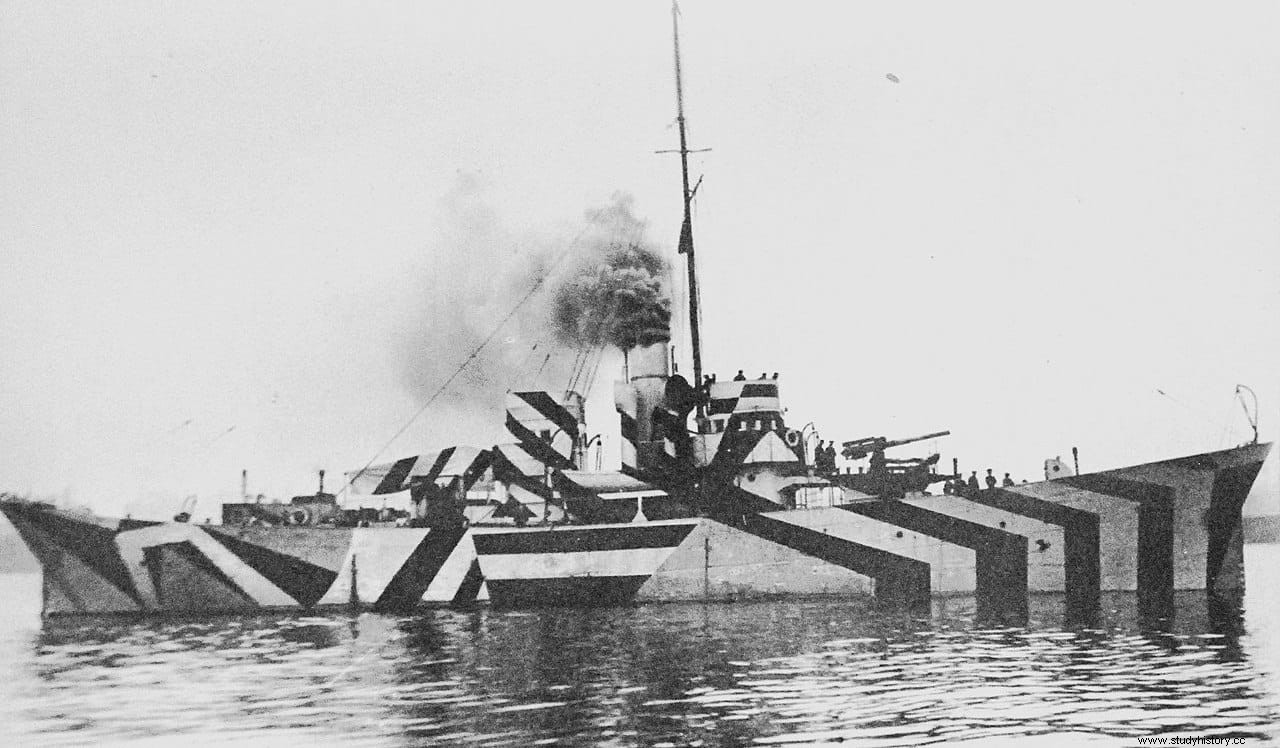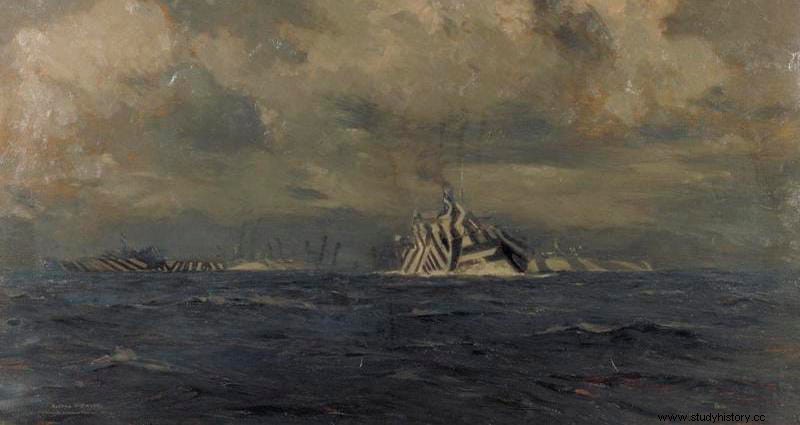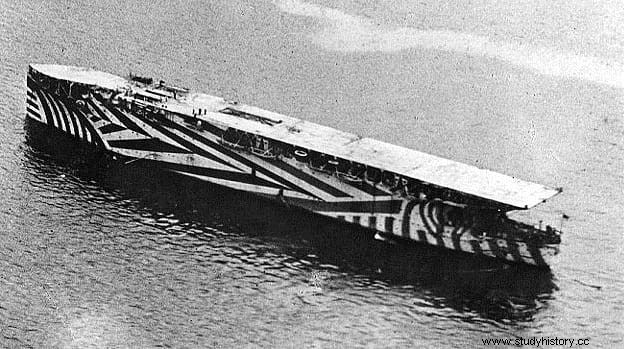At the beginning of 1917, the equator of the First World War was widely surpassed. , the situation in Germany was becoming desperate and Kaiser Wilhelm authorized a new strategy to fight at sea and to face the increasingly overwhelming superiority of their enemies:an open submarine warfare and without restrictions in which any ship would be susceptible to being torpedoed. As a consequence, the percentage of subsidence of British merchants - a fifth until then - skyrocketed to an average of 23 weekly, which totaled almost a thousand at the end of that period.
For Great Britain, sailing became a serious risk of ending up at the bottom of the ocean if a U-Boat was nearby, so it was necessary to take some kind of measure tocounteract the situation . One of the attempted answers was the so-called Dazzle Section , a new merchant naval division that was presented to King George V in late October during a port visit. The monarch was able to see in situ a small ship that, as a model, had been painted in a completely different way to what had been seen until then and, of course, very far from the classic metal gray.
In fact, she was quite bizarre, with a real explosion of stripes in contrasting black and white arranged in all directions. The boat was placed on a rotating platform but in such a way that only the sea could be seen around her, just as she was sailing. They then invited George V to calculate his orientation observing through a periscope that was 3.5 meters away. The sovereign had served in the Royal Navy before succeeding his older brother to the throne, so he knew what he was doing:"South-West" was his reply.

Norman Wilkinson , head of the new department, corrected him: “East-southeast”. It is not that the king had lost faculties; it is that he had been deceived by the unusual painting of the ship. The Dazzle effect , a word that can be translated as dazzle, was based on a novel idea:instead of camouflaging the ship, something that was impossible against submarines, it did the opposite, which was to highlight its presence but to confuse the enemy and camouflage its course and position .
This is explained because the U-Boat gunners had to fire from a distance of approximately 1,900 meters , not only to avoid being discovered but also because the torpedoes required to travel a minimum distance before arming. Hence the need to calculate with some precision where the target would be based on its defeat; apart from having only half a minute for all this -under penalty of the periscope wake being sighted- and that the submarines only carried a dozen torpedoes that should not be wasted.
According to Wilkinson, that painting could distort the position of the ship , in the eyes of a submarine, between 8 and 10º. Enough to make him miss the shot - well totally, well partially - and get to safety. The contrast of layers of colors arranged in geometric shapes they confuse the vision and make it difficult to calculate the dimensions of the ship, its shapes and its direction. For example, painting curves in certain places creates the sensation of a stem cutting through the waves, imagining the bow where it really isn't. For the observer it is difficult to establish exactly where the ends of the ship are, if there is more than one, which part is the bow and which is the stern... Some lines painted on the chimney lead us to think that it is heading in the opposite direction to the true one.

The Dazzle effect is a concept that is often defined as reverse perspective or forced, an optical illusion similar to the typical photo of a tourist holding the Tower of Pisa. However, the system had its limitations and was only useful against submarines , since they observed through a periscope and from below, but it surpassed all previous attempts to camouflage ships, some as surprising -and impractical- as covering them with mirrors, covering them with canvases that resembled clouds or islands, and even disguising them as whales (!).
Wilkinson, an amateur painter (previous photo) and a sailor who had volunteered at the outbreak of the war, picked up and perfected the idea of camouflage that had previously been formulated without much success by a Scottish naturalist named John Graham Kerr . That little ship that tricked George V, named HMS Industry , was launched in May 1917 to expand the experiment :He had to sail along the British coast to see how the patrol boats and coastguards could distinguish him. The results must have been satisfactory because in October Wilkinson was asked to prepare the camouflage for fifty ships troop carrier.
A team made up of 19 people , including 5 artists and 11 other art students - one of whom would end up being Mrs. Wilkinson - prepared the designs to be applied to the ships. All different to prevent German crews from getting used to them and because they had to adapt to the morphological characteristics of each unit. They went from paper to scale models to verify that they gave the desired result and from there to the authentic ships, painted in dry dock. By June 1918, 2,300 units had been camouflaged. , which would double before the end of the war.

It was also tried to apply it to United States ships . However, it seems that the US military did not take it too seriously, except for those who considered it directly offensive. There is correspondence from some commands in which there are ridicules about it , calling the ships thus painted jazz ships . Not just the military; the press in general took the matter to chirigota, with caricatures and simplistic allusions to contemporary art and Picasso. The same did not happen with the insurance companies :Whether sinking was reduced or not, it was noticed that the system increased morale on board and, consequently, they reduced their policies .
There is some controversy about it. The statistics collected by the British Admiralty recorded 10% fewer sinkings in the first quarter of 1918 compared to the same period of the previous year:62% compared to 72%. However, during the following quarter that result was reversed. In 1919 a laboratory study was made under conditions similar to those faced by George V and it seemed to confirm that the model induced errors of up to 58º, which is significant because, as we said before, 10º was considered enough to miss the shot. In 2011, the University of Bristol did a new study and also drew positive conclusions, although experts believe that it will never be possible to determine exactly whether or not the strange painting played a role in the German attacks.
At the end of the conflict, Wilkinson and Kerr had a certain confrontation over the paternity of the idea , which was settled with the victory of the first recognized by the Navy. But it didn't take long for World War II to break out and Dazzle paint was given the chance to relive a new golden age. Ephemeral, yes, because the reality prevailed that maintaining it for so long was very expensive , so he returned to the sober gray hulls.
